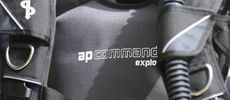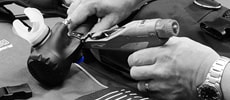- Photo by Peter Den Haan
Rebreather Safety & Bailout Procedures
There are 5 Inspiration Rebreather Safety & Bailout methods you should know about:
In general, everything happens much slower on a rebreather than other types of dive kit. With multiple unit monitoring systems and warnings that are flagged up well before issues become problems - instead of seconds to react, more often, you will have many minutes before anything becomes critical - a long time underwater and plenty of time to consider your options and respond. And when you do - you have a range of options to choose from:
1.Diluent Flush
As gas consumption is so low – typically only 30-40 bar per dive – a large proportion is available for either a diluent flush of the loop or open circuit bailout. The diluent gas provides a key safety option: it can be manually injected into the inhale counter lung - offering a "sanity-check" - to immediately supply gas which is both instantly breathable and a ‘known’ mixture – allowing the diver to check and validate his oxygen sensor readings.
-
Flight by HUD
The Inspiration range with Vision electronics comes as standard with a Heads-up Display - two independent pairs of LED lights one green, one red for each controller. The LEDs work down to low voltages, so even if both power supplies are nearly out, the wrist display has faded and the solenoid has stopped firing, the LEDs (or even just one LED pair!) will continue to provide data on the status of the oxygen pressure, allowing you to perform a closed circuit egress with manual gas addition.
-
Manual Flight
In the very unlikely event that both controllers - master and back-up - have failed and therefore, also your HUD, you are taught on your course, the bailout procedure of "manual flight". In this scenario, you can maintain a life-sustaining PO2 in the loop by the manual operation of the oxygen or diluent inject valves on the counter lungs and perform a closed circuit egress.
-
Open Circuit Bailout
If there is doubt about the ability of the unit to control your PO2 - there is the option - "If in doubt… Bailout" and you can switch to whichever open circuit bailout contingency you have to hand - OCB mouthpiece, Auto Air or a side-mount bail-out regulator. This may be a complete bailout or just a break until you can sort out the issue and resume the dive on the closed circuit.
The OCB mouthpiece has a simple switch to instantly access whatever open circuit gas you have connected to it, either from the onboard diluent or an off-board cylinder. The Auto Air – emergency demand valve / inflator (EN250 quality) is fitted as standard and the bailout procedure is to simply close the CCR mouthpiece, come off the loop and swap it for the Auto Air to breathe directly from the diluent cylinder. Alternatively, a regulator may be fitted to the diluent cylinder (provided it is a downstream type) or other bail-out second stages to side-mount or deco gas cylinders.
-
Pure O2 Bailout at 6m or above
Another option is to fit an oxygen clean 2nd stage (with isolator valve) for emergency breathing of pure O2 from the oxygen cylinder at 6m and shallower.
The volume of bailout gas is as much a limiting factor to your dive planning as the gas configuration selected. Proper pre-dive planning is essential to ensure that you have sufficient volume of respirable bailout gas for the type of dive intended to allow a safe ascent on open circuit at any stage.





